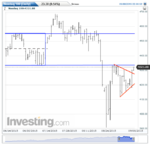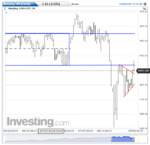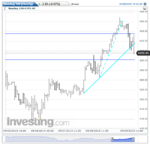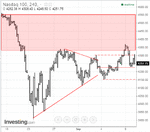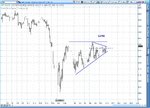From the attic:
A line chart is suggested only because the usual charting sites don't offer tick charts. And even some charting programs don't offer the tick option unless you pay extra for it. But a line chart does nothing except connect the price points with a line.
Wycoff, of course, did not maintain intraday bar charts. How could he? But then maintaining intraday bar charts is a relatively new phenomenon. Unless he was scalping, he'd find his spot on daily charts, then monitor the intraday action in order to get as close as possible to the point where the stock was "ready" to move and where risk would be minimized, but he wouldn't be using charts; he'd be using P&F, or just keeping track in his head.
In other words, he'd know, as in the case of JPM, that 25.5 was important. If he was going to take his position intraday, he'd then watch what traders did when price approached that level. He'd note where price was straining to advance. He'd watch the activity to see where the balance between buying pressure and selling pressure lay. He'd then take his position just under that point where price kept "hitting a wall". The idea of waiting for the clock to tick over 5 minutes or 15 minutes before he opened his position would have seemed ludicrous to him, much less wait an hour. What would be the purpose? There is, after all, no "close" during the day, but rather a continuous flow of trading activity and price movement.
So why didn't Wyckoff use line charts rather than bar charts for his daily record-keeping? They certainly would have been simpler and faster. But there is a lot of information contained within that daily bar. If you're listening to the market's story, each bar will tell you something of the balance of power between buyers and sellers and how hard each of them has tried to advance price or pull it back. Wyckoff understood the inescapable fact of continuous price flow. When he looked at a bar, he saw not a bar as a finished product but the waves and currents and eddies of buying and selling pressure that created the bar. If you want to be fanciful, it was not a stick of dead wood with a bump on it here and there but rather a "flash" stick. The bar, for him, was nothing more than a summary of what buyers and sellers did to create it, nor did it have any particular importance beyond its place in the continuous flow of trading activity and price movement. As long as one is sensitive to this flow and in synch with it, he can apply W's approach to his trading without using bars at all, or even charts.
Since intraday bar charts have been around for a generation, those who are less than middle-aged may have difficulty seeing price movement in any other way. Line charts are merely a bridge to the realm of continuous price movement. Your charting program may provide several options -- line on close or open or high or low or a high/low average or a high/low/close average or whatever -- but which you choose is largely irrelevant, including the interval on which the line is based: tick, minute, hour, and so forth. To attach too much importance to how the line is plotted is to generate the same mystique and pseudo-importance that is attached to the bar.
It's not about jogging from side to side for five minutes or fifteen minutes or an hour then jumping ahead and running side to side for another five or fifteen minutes or hour. It's about putting one foot in front of the other, again and again, maybe forward, maybe angling this way or that, maybe turning around and returning to the starting point, but always moving, always one foot in front of the other, sometimes slower, sometimes faster, but always moving.



